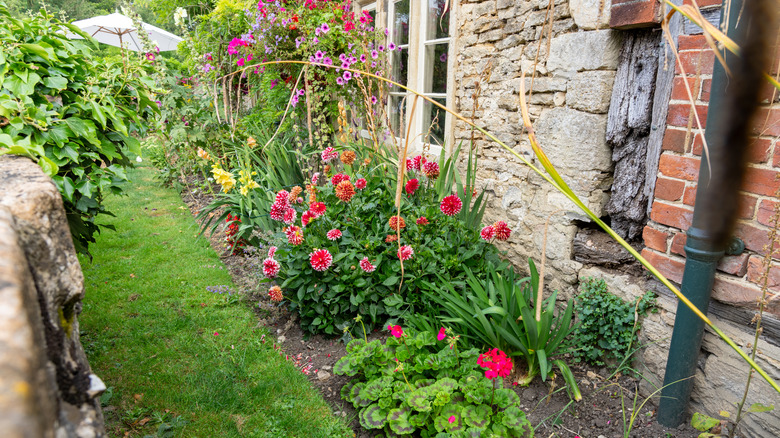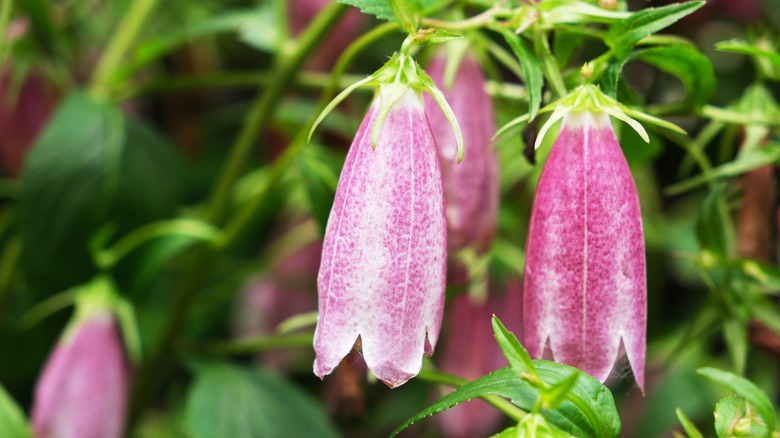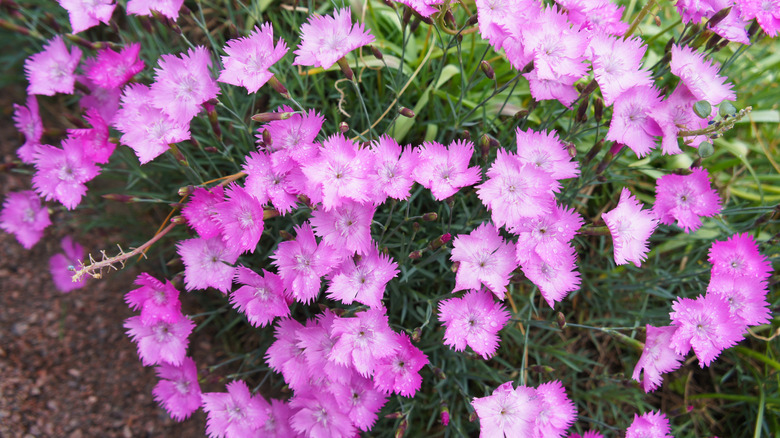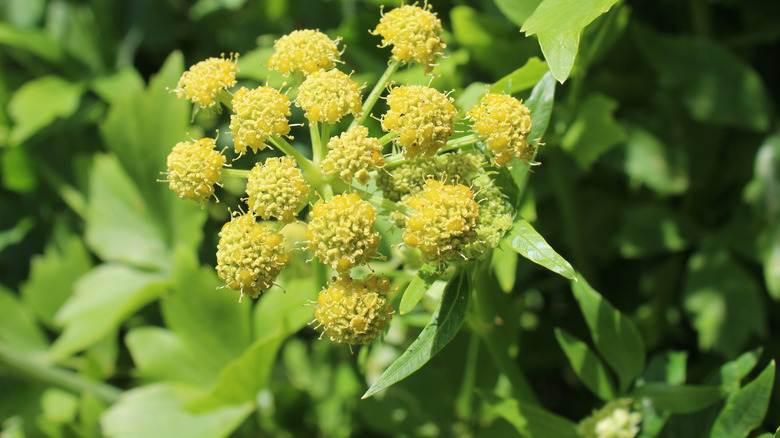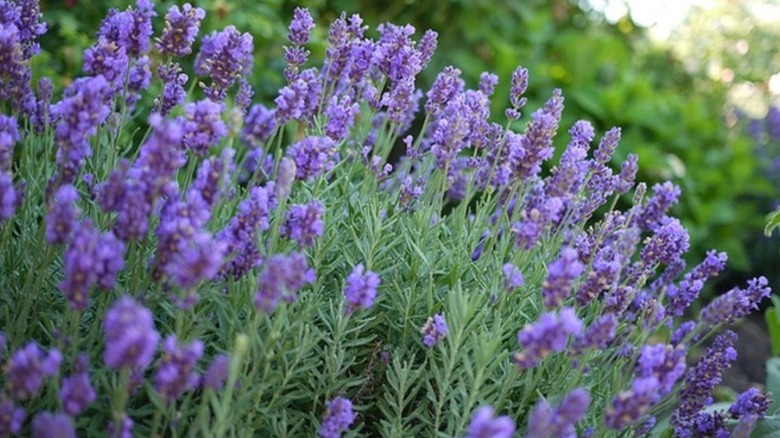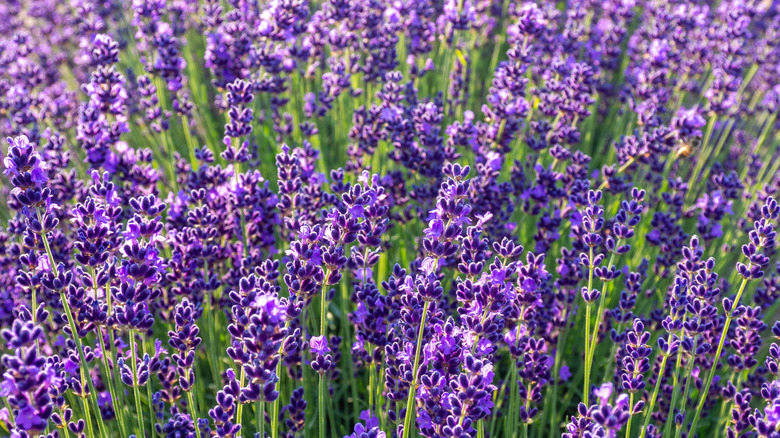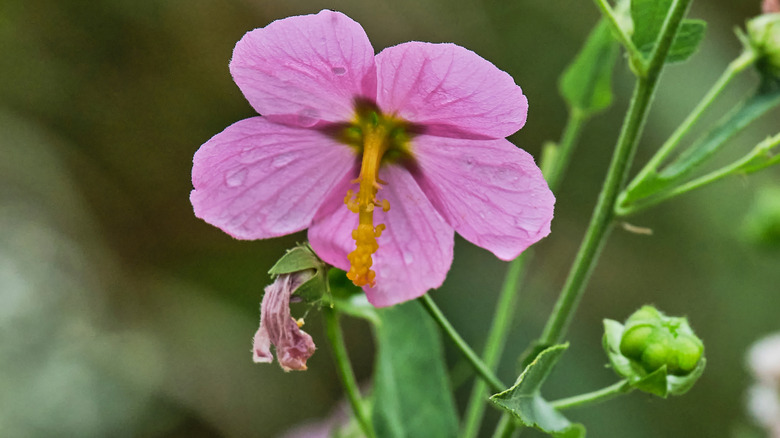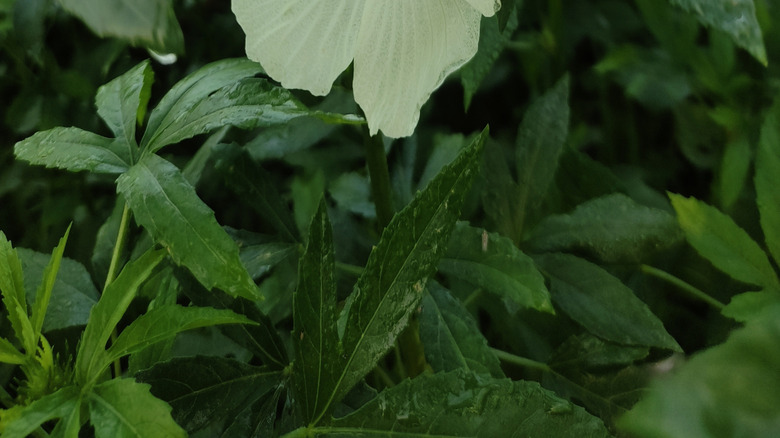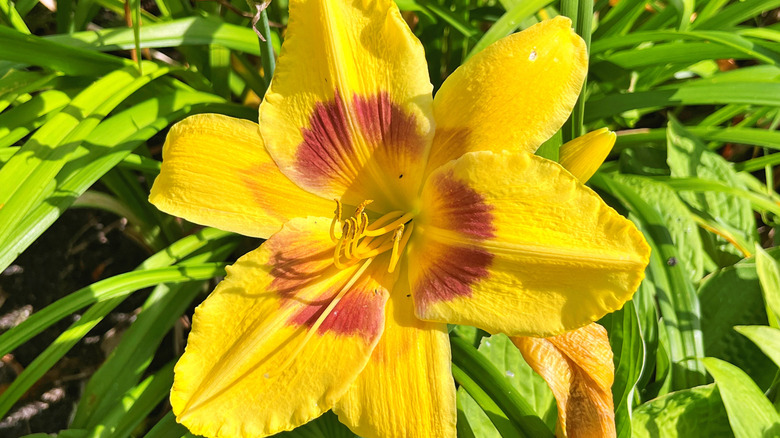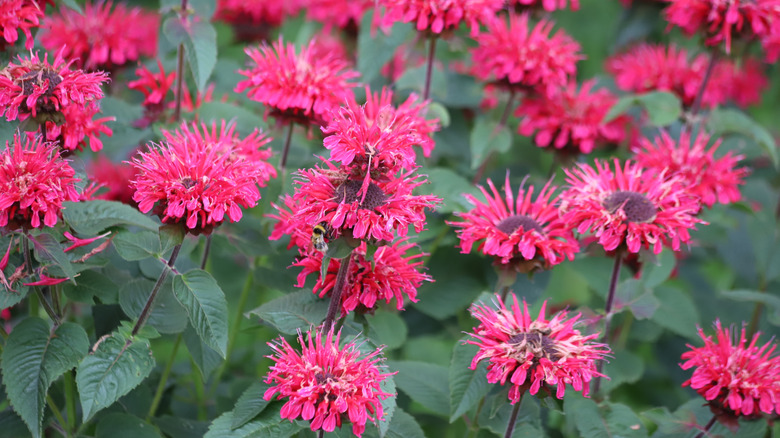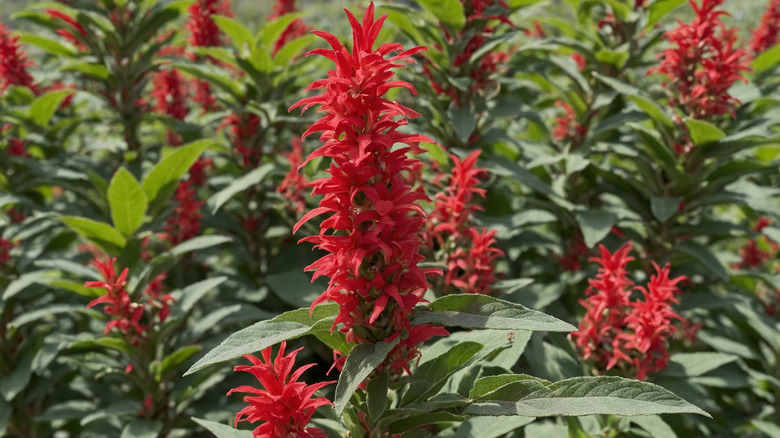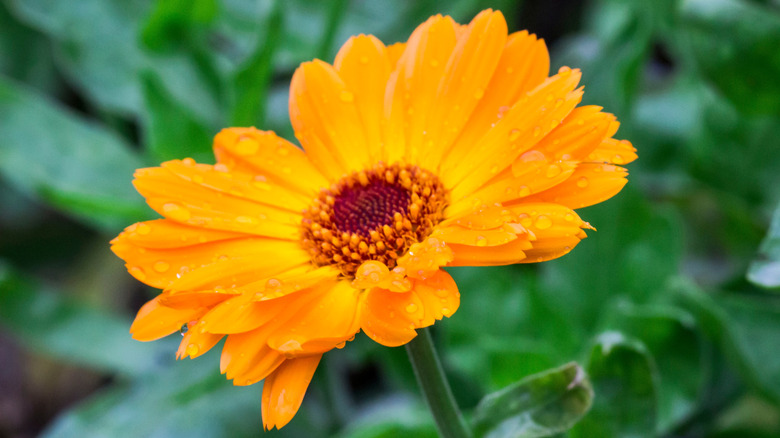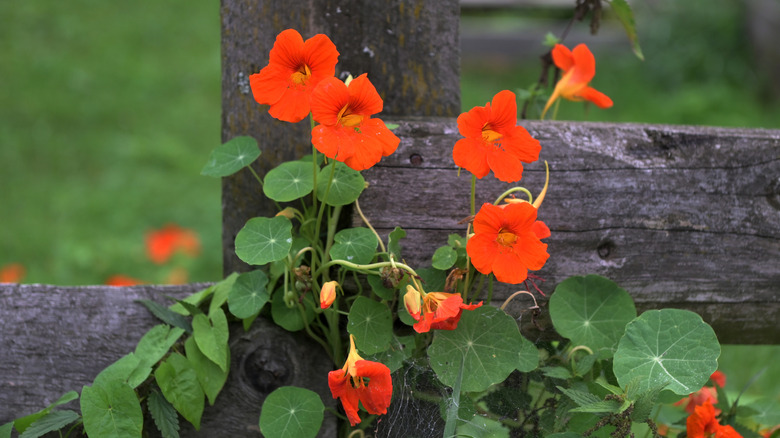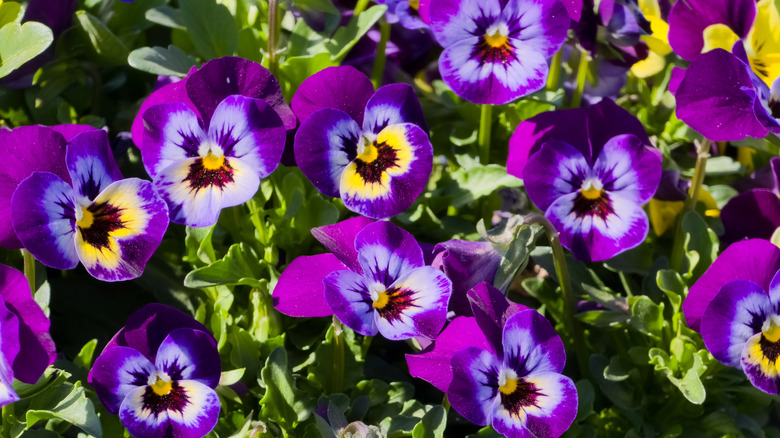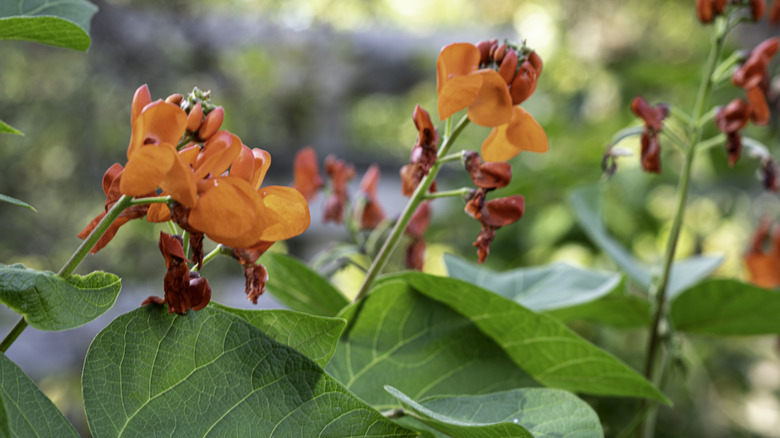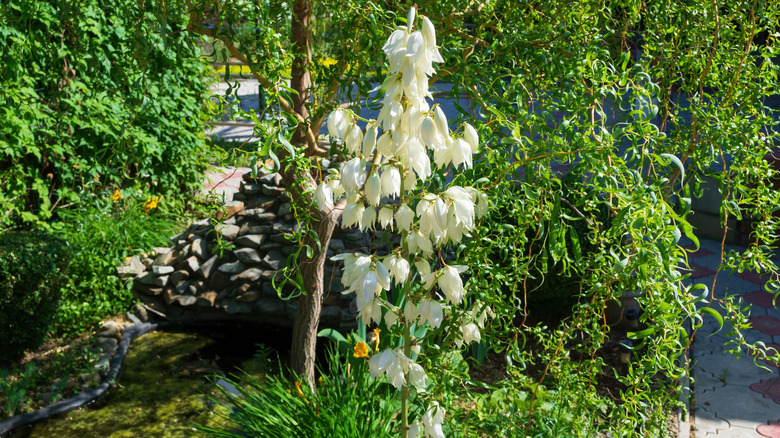The Best Edible Flowers You Should Start Planting In Your Garden
There's something magical about nicking flowers from your own garden and tossing them into dinner. Not to mention, it does feel immensely satisfying to take in your guests' stupefied expressions when you let them know you grew the flowers floating in their iced drinks. The best part, though? It isn't even that complicated. In fact, chances are you're already growing a few of them, maybe because they have long blooming periods or are popular with pollinators — think nasturtiums, hyssop, pinks, roses, and beebalms.
But before you embark on the journey of growing an edible garden and eating it too, make sure you're only purchasing organically produced seeds or starts. Also, avoid plants that prone to diseases, as any chemical treatment to protect them will preclude you from using their blooms. Aim to harvest flowers in the morning, and consume them only after running them through cold water and air drying. Extra blooms can be refrigerated for a few days. Bear in mind that not all flowers are flavorless, pretty garnishes. Calendula and pineapple sage, for instance, taste sweet. So, you should test-check the blooms before throwing them onto your salads. With that clarified, here are 28 edible flowers you should plant in your garden.
Anise hyssop
Starting in June, anise hyssop (Agastache foeniculum) features waves of edible, bluish-purple blooms that last through the fall. You may use their tiny petals to flavor teas or as garnishes. Besides their blooms, their leaves are equally flavorful, carrying undernotes of licorice that add a tasty pop to salads. If you allow the plant to set seeds, which you should, since songbirds enjoy them, you can use the extra seeds in your baking goodies. Anise hyssop provides perennial color in USDA zones 4 through 8. It tolerates lean, rocky or sandy soils with full-to-part sun exposure.
Hollyhock
Available in an array of colors, including lavender, pink, yellow, and maroon, hollyhocks (Alcea rosea) are great for adding vertical interest in your garden. They grow over 5 feet tall and can be massed in borders to deter rabbits. Their flowers are equally massive at 5 inches and make beautiful garnishes. You can also be more playful by turning them into cute containers, a natural function for their pretty cup shape. Hollyhocks have a long blooming season, spanning June through August, and are excellent for pollinator gardens in zones 5 to 9. Plant them in a sunny site for the best blooms.
Begonias
Certain begonia varieties, such as wax and tuberous, produce edible flowers. These pastel-hued petals pack a mild tart punch, which can enhance your Mediterranean diet of sandwiches and salads. Those who spend their summer evenings with a cocktail glass and cheery company can earn awe and applause for freezing the petals in ice cubes for that ornate flourish. Begonias overwinter only in zones 10 and 11 and are grown as annuals elsewhere in moderately shaded sites. Make sure your children and furry pets don't touch the plant, as the sap can irritate their skin.
Spotted bellflower
If your love for K-dramas has filtered through into your food preferences, coaxing you into trying out Asian flavors, consider planting spotted bellflower (Campanula punctata). This delicacy, also known as dorajee, has edible leaves that are great for seasoning salads. However, you don't want to wait too late in the summer to harvest them, lest they turn bitter. Spotted bellflowers are excellent in cottage or rock gardens, where they remain in bloom in spring and summer. If you find them weedy, pull out the seedlings and cook their edible roots. Zones 5 to 9 are their ideal range.
Roman chamomile
Roman chamomile (Chamaemelum nobile) is a soothing herb you should plant in your garden borders or along pathways for its fragrance — or if you like teas. Their daisy-esque, white blooms appear in summer, and again in fall, weather allowing. When plucked and dried, they can be steeped for a pleasant cup. However, don't go overboard and limit yourself to a cup a day (or none if you're pregnant), as consumption in greater quantities can trigger allergic reactions and diarrhea due to thujone. Sensitive individuals may experience skin irritation after touching the foliage. Grow chamomile in zones 4 through 9.
Saffron
Tired of paying eye-watering prices for saffron (Crocus sativus)? How about giving this perennial a home in your garden, provided you're housed in zones 5 through 8. In the fall, saffron produces lavender blooms, albeit for a short, fortnightly period. At this stage, remove the orange stigmas protruding from the petals and crush for spice. You can save the extra for later consumption in airtight containers. To ensure a successful harvest, grow saffron in organically-rich soils receiving ample sunlight. Avoid wet sites, lest the blooms fall prey to fungal diseases. Over time, you may divide their corms for new plants.
Cheddar pinks
Cheddar pinks (Dianthus spp.) are low-maintenance flowering plants that thrive in the sun in zones 4 to 9. Not only are their wheeled blooms aromatic and showy, they're edible, too. But make sure to source them from organic growers before consuming. Dried petals from pinks can be sugar-crystallized for cakes. Avoid touching or consuming their leaves, as they may induce contact dermatitis and vomiting. Cheddar pinks are ideal in city gardens, given their tolerance for pollution and drought.
Fennel
Planted in spring, fennel (Foeniculum vulgare) rewards its growers with yellow flower umbels in the summer. You may pluck their petals to sweeten dishes, after leaving some for butterflies and beneficial bugs. When the flowers grow discolored, snip them off to prevent seed production, as they're notorious for naturalizing in the wild. In fact, check with the local county before planting, especially if you live along the West Coast, where it's invasive. Fennel is fairly easy to grow, as it tolerates poor soils, drought, heat, and humidity, and remains untouched by pests, including deer. It is perennial in zones 4 to 9.
Sweet woodruff
Sweet woodruff (Galium odoratum) is an easy-to-grow herb that thrives in shade with little to no sun. In fact, you can even plant it around black walnut trees, as it's tolerant of juglone and forms a highly aromatic groundcover. Pick the star-shaped, white blooms in spring to add a nutty, vanilla flavor to your beverages. But consume them in limited quantities, as they have a blood-thinning effect. Apart from flowers, you may also harvest their leaves for potpourris. Sweet woodruff is evergreen in zones 4 to 8 and should be grown in well-watered, fertile soils.
Lovage
Lovage (Levisticum officinale) is an all-star herb you can consume whole. Greenish-yellow blooms, present in spring, can be sprinkled in broths as a celery substitute, while the seeds that follow afterward can be baked into breads. Their parsley-shaped leaves can elevate stews, teas, and meat. That said, you've to be mindful of their location. Lovage can be a voracious grower in gardens and is known to escape its bounds if its seeds aren't routinely harvested. Also, it isn't pet-friendly. You may grow lovage in zones 4 through 9, except in New England, where it's invasive.
Lavandin
Don't let alkaline soils deprive you of the joy of growing edible flowers for lavandin (Lavandula x intermedia). This hybrid of English and Portuguese lavender thrives in such substrates. Their tiny, lilac petals that unfurl all summer, along with the leaves surrounding them, can be had fresh or as garnishes in salads and soups. Alternatively, you may extract oils from their blooms as a food flavoring agent or dry them to make a flavorful tea. New growth on lavandin isn't very cold-hardy, so it should only be pruned in spring after the last frost. Growth range spans zones 5 through 8.
English lavender
English lavender (Lavandula angustifolia) is a culinary favorite since its pretty purple flowers sweeten a range of dishes and drinks. But if you're looking for something stronger to enhance your cookies, look for its cultivar 'Munstead'.Those who can't live without tea can consider saving their flower buds and immersing them in hot water after drying. English lavender is popular with pollinators, but must be kept away from pets. In zones 5 through 9, you may plant it in dry, sunny sites, as it's drought-tolerant. Be sure not to overcrowd or overwater the beds, as it's highly susceptible to a range of diseases.
Seashore mallow
An east U.S. native, seashore mallow (Kosteletzkya pentacarpos) is another attractive and edible flower hardy in zones 6 to 9. Its pretty pink blooms that burst out from July through October can instantly enhance the look of your salads and floral teas, adding a mild flavor and texture. Outside its blooming season, you can cook mallow's leafy buds and new leaves for a taste similar to its flowers. Protein lovers should wait until the plant produces seeds, which can be roasted for a nutrient boost.
Hyssop
Hyssop (Hyssopus officinalis) is a culinary herb whose young leaves and flowers are used for flavoring dishes. Its compact size reads great in containers, which can be maintained on a sunny kitchen counter for ease of use. Otherwise, give this edible a home in pollinator gardens to feed bees and butterflies through the summer. Hyssop may also be planted as a mini-hedge to check erosion or deter deer. Hardy in zones 4 through 9, it prefers full sun exposure, but will want protection from the afternoon heat in hot climates.
Roselle
Roselle (Hibiscus sabdariffa) is a statement maker in the garden and on your plates. Once the days become shorter in the fall, it blooms pink-blushed, white flowers that you may steep for teas or color dishes. Even their sepals find plenty of use in jams and jellies. Those who find spinach too mild for their tastes can spice things up by cooking roselle leaves instead. Roselle offers perennial interest in zones 8 to 11 and is an annual in cooler areas. Give it a home in water-wise landscapes, as it's a trooper against dry, hot conditions and requires minimal irrigation.
Daylilies
Daylilies (Hemerocallis spp.) are some of the best edible ground cover plants that'll make your garden look (and taste) amazing. When they're in bloom during spring and summer, they brighten the garden with yellow or orange tubular flowers, animated further by hummingbirds and butterflies. Pinch a few petals off and lace them over your food when out of asparagus, since they taste so similar. Go easy on it though, as they've a laxative effect in greater quantities. Daylilies can be grown in zones 3 through 9 in organically rich soils, with at least partial sun exposure.
Scarlet beebalm
Those who're into native gardening are perhaps no stranger to the allure of scarlet beebalm (Monarda didyma). This herbaceous perennial attracts ruby-throated hummingbirds, bumblebees, and butterflies with its summer-blooming, scarlet flowers, while several stem-nesting bees overwinter in their hollow stalks. But the benefits don't stop at creating wildlife value; gardeners can simultaneously grab a few flowers to flavor their teas, salads, and stews, as they're edible. To grow scarlet beebalm, you must be located in zones 4 through 9 and offer it a sunny site. Be warned, they can take over garden beds if not regularly deadheaded.
Roses
Unsurprisingly, roses (Rosa spp.) also carry edible parts — petals and the hips (or fruits) that follow afterward. Their fragrant petals are great, fresh or dried, in salads and desserts. Though you must remove their white bases so as not to detract from their sweetness. Rose hips, on the flip side, are utilized in jellies and floral beverages. When using roses for consumption, stick to native or heirloom varieties, as they generally have a sweeter taste profile — the local wildlife will thank you for it. Among Asian imports, rugosa rose (R. rugosa) fares best. Roses grow best in zones 5 to 11.
Pineapple sage
Jazz up your palette by sprinkling in flowers plucked from pineapple sage (Salvia elegans). Their lipped blooms — which understandably are a hummingbird favorite thanks to being red and rich in nectar — taste fruity, and may be used in jams, jellies, and cream cheese. To grow these hummingbird magnets, find a space in a sunny, fertile bed (although it can tolerate poor soils). You may pop them in borders to relish in their aromatic foliage that deer, thankfully, despise. Pineapple sage is perennial in zones 8 to 10 but can also be grown as an annual.
Tulips
Tulips (Tulipa spp.) stand apart from the lot of edible flowers, as they aren't utilized as garnishes. Instead, they're cooked as vegetables. Depending on the variety, they may taste closer to cucumber, lettuce, or peas. But since they contain allergins, which may induce vomiting and nausea, you shouldn't consume them in large quantities. When planting tulip bulbs, wear gloves to avoid skin irritation. Except for species tulips, most hybrid varieties are grown as annuals. Tulips require at least six hours of direct sun exposure and organically rich soils for the best performance.
Calendula
An edible flower that also attracts bees and pollinators to your garden? Meet calendula (Calendula officinalis), or pot marigold, as it's also popularly known. Not only will calendula blooms add a peppery pop to your salads and cookies, they're also great as yellow-coloring agents for stews and rice. To ensure their steady supply throughout spring and summer, stay on top of deadheading. Even though they're grown as annuals throughout the U.S., calendulas tend to reseed in the area, returning reliably for years after. Be warned, in drought-prone, hot climates, they'll look drab during the summer, but pruning will rejuvenate them in time for fall.
Nasturtium
Except for its roots, nasturtiums (Tropaeolum majus) can be consumed whole. From spring through fall, as they're actively blooming, you can tug away the blooms to add color and tangy flavors to salads. Their leaves, seed pods, and seeds are similarly edible. Flower buds can be used as seasonings because they're rich in mustard oil. Since nasturtiums are also popular with pollinators, consider massing them in beds to get the best of both worlds. They can survive in poor soils as well as areas prone to dry spells. Although annuals, they readily self-seed in gardens.
Pansies
Pansies (Viola x wittrockiana) are some of the most popular bedding plants — for a good reason. They provide vivid color for over four months during winter and spring, in your garden as well as dishes. Since they're available in a rainbow of colors, you can depend on them to instantly lift your food's visual interest. Or, you can crystallize them with granulated sugar for cakes. Pansies also pair beautifully with cream cheese and crackers. Since they tolerate clay, sand, and textures falling in between, pansies are fairly easy to grow. Grow them along pathways where you can watch the butterflies visiting them.
Lemon balm
Hardy in zones 3 through 7, lemon balm (Melissa officinalis) is a fast-growing, aromatic herb that also produces edible flowers. These tiny, two-lipped, white blooms remain on display throughout summer and fall and are super popular with the bees. You may steep them along with the minty green leaves to flavor stews and iced teas. Flowers that couldn't make it to your cups and are retained on the stalks must be duly removed when they fade. Otherwise, the plant may overtake your garden through self-seeding. Alternatively, you can keep it contained in patio planters.
Scarlet runner bean
Scarlet runner bean (Phaseolus coccineus) is a frost-tender, short-lived perennial vine in zones 7 through 11. It also grows well as an annual in cooler regions for ornamental beauty and edible use. This stunner shows sprays of red petals mid-summer onward, luring in hummingbirds and bumblebees. But you can snip a few to add crunch and a mild, beany taste for salads. The soft green pods and beans that follow these flowers are edible too. If you aren't a fan of bean pods or dry beans, you can remove them every so often to push the plant into producing more blooms.
Sweet marjoram
You might like sweet marjoram (Origanum majorana) for its fragrant leaves that are great in floral teas. But you don't have to bemoan the leaves turning bitter just because the herb began flowering. The tiny white blooms not only provide late-summer food to local bees; they're edible too. Use them in dressings or sauces for a sweet-tangy punch, but in moderate quantities. Sweet marjoram is perennial only in zones 9 and 10, but you can overwinter it indoors in other regions. Locate the containers in areas receiving over six hours of direct sunlight away reach of pets.
Mountain mint
Endemic to the central and eastern U.S., mountain mint (Pycnanthemum tenuifolium) is another edible flower you can grow if you're looking to naturalize an area. Otherwise, you may have to plant it around hardscaping, such as ponds or walkways, to contain its spread. Mountain mint reliably enlivens summer and fall gardens with pink-flushed white blooms that bring in droves of butterflies and bees. But you can collect its flowers and young leaves, and use them for flavoring teas after drying. Grow this perennial in zones 4 to 8 in slightly acidic soils with full-to-part sun exposure.
Curlyleaf yucca
Indigenous to the southeast U.S. region, curlyleaf yucca (Yucca filamentosa) is a low-maintenance perennial you may grow for a myriad of benefits. Creamy white flowers, in bloom during spring and summer, can be had raw, roasted, or sauteed in a range of foods if you like the flavor of artichokes. Besides being edible, they hold a significant draw on hummingbirds, moths, and skippers. Their resistance to heat, drought, salt, erosion, and pollution makes them a highly versatile planting. Deer, rabbits, and squirrels avoid their foliage, but you may have to teach your pets to steer clear of them.
